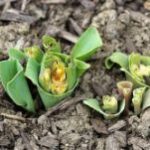Spring Bulb Protection and Care
When the tulips start to emerge, your best bet is to spray them daily or every other day with a good rabbit repellent as weather and time reduce their potency. I have had luck with Liquid Fence. However, there are many products on the market such as Rabbit Scram, Plantskydd and even hot pepper spray. Every garden can be different, so you might need to experiment with a few.
In my garden I use wire hanging baskets or anything else I can find to cover sprouts as they emerge.You can use wire wastebaskets from a dollar store. I even scour thrift stores for old bird cages. My yard isdotted with them in the spring, and it’s actually pretty cool looking!
Typically, once the tulips are up about 4 to 5 inches, other tasty greens are available and the critters might not be so aggressive. I usually take the cages off my tulips once the bud appears


If you love spring bulbs but don’t want to fight with nature, daffodils. muscari and hyacinth are all deer and rabbit resistant. So go for those next year instead! Daffodils and snowdrops are not “lunch box” fare for rabbits. They contain a poisonous substance call lycorine. Allium, while not poisonous, don’t appeal to most animals because they don’t taste good to them. Other bulbs less likely to be consumed by critters are crocuses, grape hyacinths, snowdrops, and Siberian squill. (Note: Siberian squill is also known as Scilla and spreads alarmingly!)
Should planting tulips be a must, consider planting them scattered among the less savory types of bulbs. While it may not be the best form of discouragement, it can give your tulips a fighting chance.
Tulip Problems
Easy to grow, tulips are not faced with many problems. Let’s cover the most popular ones:
- Disappearing bulbs: After you have planted your bulbs in the fall, cover planting holes with hardware cloth or chicken wire to avoid them being dug up. You can also soak your bulbs in Coyote or Fox urine prior to planting. This smell is awful and keeps them from getting eaten.
- Blossom stalks are short: Not enough chilling; unseasonably warm winter and very cold spring temperatures. This can also happen if the bulbs were planted too deep.
- Leaves appear, but plants don’t bloom: Not enough chilling; leaves removed too soon the previous year; poor soil fertility; not enough sun. Bulbs need at least half a day of sun while the leaves are green.
- Over the years, fewer plants and blossoms appear: Decline due to overcrowding, poor soil fertility, increasing shade
After blooming care
This is important and many people make the mistake of cutting off the brown leaves as they are dying back. Those spring blooming bulbs need the photosynthesis that goes through those leaves and into the bulb. That is how they store up energy to bloom the next year. So, resist the urge to cut off the dead stuff and hide that unsightly foliage with annual and perennial plantings.
Assuming you’ve protected your bulbs enough to get blooms, it is important to continue to care for them.
If your soil is poor, it is a good idea to fertilize after blooming to help next year’s bloom. Use a bulb food fertilizer. A low nitrogen 5-10-5, up to 12-12-12 fertilizer is best. Don’t fertilize when the plant is in bloom.
To protect your plants in the fall, after the ground freezes, cover your bulbs with 2 – 4 inches of mulch to keep the soil at a more consistent temperature.
Here’s to enjoying your bulb plants more than the critters!
Sources:
Total Landscape Care
Midwest Gardening






